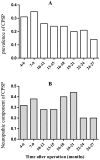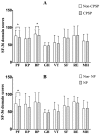A retrospective study of chronic post-surgical pain following thoracic surgery: prevalence, risk factors, incidence of neuropathic component, and impact on qualify of life
- PMID: 24587187
- PMCID: PMC3938555
- DOI: 10.1371/journal.pone.0090014
A retrospective study of chronic post-surgical pain following thoracic surgery: prevalence, risk factors, incidence of neuropathic component, and impact on qualify of life
Abstract
Background: Thoracic surgeries including thoracotomy and VATS are some of the highest risk procedures that often lead to CPSP, with or without a neuropathic component. This retrospective study aims to determine retrospectively the prevalence of CPSP following thoracic surgery, its predicting risk factors, the incidence of neuropathic component, and its impact on quality of life.
Methods: Patients who underwent thoracic surgeries including thoracotomy and VATS between 01/2010 and 12/2011 at the First Affiliated Hospital, School of Medicine, Zhejiang University were first contacted and screened for CPSP following thoracic surgery via phone interview. Patients who developed CPSP were then mailed with a battery of questionnaires, including a questionnaire referenced to Maguire's research, a validated Chinese version of the ID pain questionnaire, and a SF-36 Health Survey. Logistic regression analyses were subsequently performed to identify risk factors for CPSP following thoracic surgery and its neuropathic component.
Results: The point prevalence of CPSP following thoracic surgery was 24.9% (320/1284 patients), and the point prevalence of neuropathic component of CPSP was 32.5% (86/265 patients). CPSP following thoracic surgery did not improve significantly with time. Multiple predictive factors were identified for CPSP following thoracic surgery, including age<60 years old, female gender, prolonged duration of post-operative chest tube drainage (≥ 4 days), options of post-operative pain management, and pre-existing hypertension. Furthermore, patients who experienced CPSP following thoracic surgery were found to have significantly decreased physical function and worse quality of life, especially those with neuropathic component.
Conclusions: Our study demonstrated that nearly 1 out of 4 patients underwent thoracic surgery might develop CPSP, and one third of them accompanied with a neuropathic component. Early prevention as well as aggressive treatment is important for patients with CPSP following thoracic surgery to achieve a high quality of life.
Conflict of interest statement
Figures



References
-
- Buchheit T, Pyati S (2012) Prevention of chronic pain after surgical nerve injury: amputation and thoracotomy. Surg Clin North Am 92: 393–x, 393-407, x. - PubMed
-
- Enck RE (2010) Postsurgical chronic pain. Am J Hosp Palliat Care 27: 301–302. - PubMed
-
- Haroutiunian S, Nikolajsen L, Finnerup NB, Jensen TS (2013) The neuropathic component in persistent postsurgical pain: a systematic literature review. Pain 154: 95–102. - PubMed
-
- Van de Ven TJ, John Hsia HL (2012) Causes and prevention of chronic postsurgical pain. Curr Opin Crit Care 18: 366–371. - PubMed
Publication types
MeSH terms
LinkOut - more resources
Full Text Sources
Other Literature Sources
Medical

